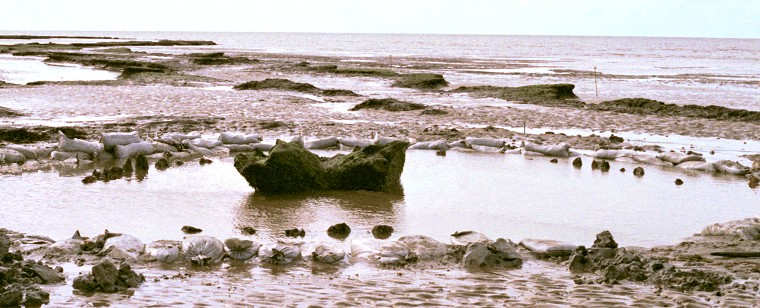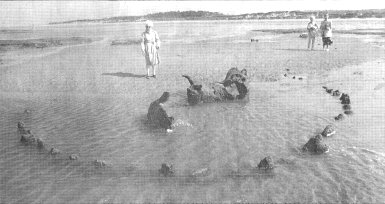 'Seahenge' June 1999. The circle has been surrounded by sandbags to try to slow the process of erosion, the posts now becoming visible due to the falling water level. There are five timbers visible in front of the trunk with around eight timbers to the left and eight to the right. The eroding peat is the dark material just in front of the outgoing tide. |
|
It consists of an oval ring of between forty-eight and fifty-five oak posts, each one cut in half and then placed next to its neighbour to a depth of over a metre with the cut side facing inwards to form a continuous 7.5 metre diameter wall around a large oak trunk buried upside down in the centre. This central oak structure is believed to have been some kind of altar, but why it has its roots pointing skyward is not clear. Some have suggested that it was for the ritual laying out of corpses, perhaps to be washed away by the sea, while others have speculated that the whole site would have originally been built on swampy ground someway inland. What is known however is that subsequent environmental changes lead to the circle being covered in peat and sand and hence being preserved in remarkable condition, it is now the erosion of the peat that has brought the whole structure to prominence once more. These peat beds have been dated to the Bronze Age, and this along with the nearby discovery of an bronze axe head of the same period, and distinctive tool marks in the wood, date the site to between about 2000 - 1200BC*. When visiting the site in June 1999, work had already begun in removing the posts to allow their preservation, as since being exposed to the elements and the rising and falling tide, the wood has now become so brittle that is starting to disintegrate. It is estimated that this task should be finished by July 1999, although it is not yet known where or when the preserved circle and altar will finally be re-erected. *Update July 2003 Update 2008 |
|
 The central trunk and roots in a preservation tank at Flag Fen in June 2003. The constant supply of water is desalinating (removing the salt from) the wood. |
|
 Detail of the trunk. In the centre is the cutaway bracket used to tow the oak into position. To the left are the marks left by narrow bladed copper axes used to debark and dress the tree 4000 years ago. |
